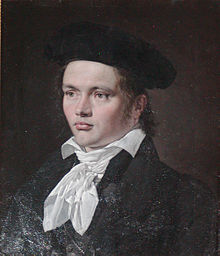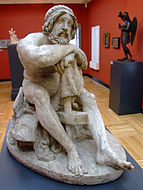| Hermann Ernst Freund | |
|---|---|
 Portrait of Freund by Christian Albrecht Jensen (1818–20) Portrait of Freund by Christian Albrecht Jensen (1818–20) | |
| Born | (1786-10-15)15 October 1786 Uthlede, Holy Roman Empire |
| Died | 30 June 1840(1840-06-30) (aged 53) Copenhagen, Denmark |
| Resting place | Assistens Cemetery, Copenhagen |
| Nationality | Danish |
| Education | Royal Danish Academy of Fine Arts |
| Known for | Sculpting |
| Movement | Danish Golden Age, Neoclassicism |
Hermann Ernst Freund (15 October 1786 – 30 June 1840) was a German-born Danish sculptor. He is remembered in particular for his figures from Nordic mythology and for the Ragnarok Frieze.
Biography

Born near Bremen, Holy Roman Empire, Freund was trained as a smith before studying at the Art Academy in Copenhagen where he was awarded all four silver and gold medals. After graduating, he spent 10 years in Rome where he became Bertel Thorvaldsen's closest assistant as can be seen in his marble bust of Bernhard Severin Ingemann (1820). An early proponent of romantic nationalism, Freund was the first Danish sculptor to work with Nordic mythology, creating 12 statuettes including Loki (1822), Odin (bronze 1827) and Thor (1829), all inspired by ancient Greek and Roman mythological works. On returning to Copenhagen, he organized the decoration of Church of Our Lady, preparing models for the figures of the 12 apostles but in the end Thorvaldsen received the commission. His masterpiece, the Ragnarok Frieze, which occupied him for many years, was completed by Herman Wilhelm Bissen after his death but was later destroyed by the Christianborg fire in 1884. There is a plaster cast of part of the frieze in Statens Museum for Kunst. The largest collection of his works is to be found at the Glyptotek in Copenhagen.
In 1829, Freund became a professor at the Academy. Inspired by time he spent in the south of Italy, Freund had his official home, Materialgaard, decorated in Pompeiian style. Young artists such as Georg Hilker, Heinrich Eddelien, Constantin Hansen and Christen Købke completed the work using Freund's designs.
Gallery
-
 Hermann Ernst Freund: Thor (1829)
Hermann Ernst Freund: Thor (1829)
-
 Hermann Ernst Freund: Font in Faaborg Church
Hermann Ernst Freund: Font in Faaborg Church
-
 Hermann Ernst Freund: Odin (1828)
Hermann Ernst Freund: Odin (1828)
-
 Jens Pedersen Memorial at Sæby Church, Hornsherred (1833)
Jens Pedersen Memorial at Sæby Church, Hornsherred (1833)

See also
References
- "Hermann Ernst Freund", Gravsted.dk. (in Danish) Retrieved 3 February 2012.
- ^ "H.E. Freund", Den Store Danske. (in Danish) Retrieved 3 February 2012.
- Jens Peter Munk, "Hermann Ernst Freund". Kunstindeks Danmark & Weilbachs kunstnerleksikon. (in Danish) Retrieved 3 February 2012.
- ^ Jens Peter Munk, "Hermann Ernst Freund", Kunstindeks Danmark & Weilbachs kunstnerleksikon. (in Danish) Retrieved 3 February 2012.
External links
Categories:- 1786 births
- 1840 deaths
- Sculptors from Copenhagen
- Artists from Bremen (city)
- Royal Danish Academy of Fine Arts alumni
- 19th-century Danish sculptors
- Emigrants from the Holy Roman Empire to Denmark–Norway
- Academic staff of the Royal Danish Academy of Fine Arts
- Danish male sculptors
- 19th-century Danish male artists
- Emigrants from the Holy Roman Empire